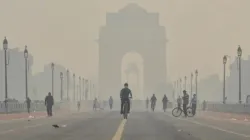Delhi govt sets up 24x7 'Green War Room' to combat winter pollution
Delhi pollution: The Green War Room will monitor AQI data and assess information from 24 pollution monitoring stations managed by the Delhi government.

Delhi pollution: The Delhi government has launched a round-the-clock 'Green War Room' to deal with the pollution in the national capital, Environment Minister Gopal Rai said on Monday. Rai said that this will enhance the execution of a 21-point winter action plan aimed at curbing pollution.
While addressing a press conference, the Delhi Minister informed that a team of eight environmental experts have been tasked to manage the war room. They have been assigned seven key responsibilities.
'War room to analyse drone mapping'
Rai said that anew task assigned to the war room this year includes analysing drone mapping and conducting real-time source apportionment studies. "The war room will also analyse satellite data of stubble burning, along with information from 13 pollution hotspots," said the minister.
Apart from this, the team will also monitor Air Quality Index(AQI) data and assess information from 24 pollution monitoring stations managed by the Delhi government, he said.
Regarding the use of artificial rain to reduce pollution, Rai said that he would once again seek approval from the central government, as his previous request had not received a response.
On September 1, Rai requested the Centre to permit artificial rain during the winter, when the city's air quality deteriorates significantly. He also urged to Delhi residents to join the fight against pollution by using the Green Delhi App, encouraging them to upload photos of any activities contributing to pollution.
Delhi government's 21-point guide for winter pollution
Earlier on September 25, the Aam Aadmi Party-led Delhi government issued the Winter Action Plan themed 'Milkar chalein aur pradushan se ladein'. The national capital every year grapples with severe air pollution levels and deteriorating air pollution levels.
Delhi is grappling with a significant increase in air pollution, with the Air Quality Index (AQI) soaring beyond the 300 mark in the 'very poor' category. This troubling trend comes as residents prepare for colder months, during which air quality typically worsens due to various factors. An AQI between 0-50 is considered "good", 51-100 "satisfactory", 101-200 "moderate", 201-300 "poor", 301-400 "very poor" and 401-500 "severe."
Recent data indicates that the AQI in several parts of the city has crossed the 'very poor' category, leading to heightened health concerns among citizens. Authorities have attributed this spike in pollution to a combination of factors, including stubble burning in neighbouring states, vehicular emissions, and construction activities.
(With PTI inputs)